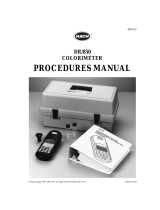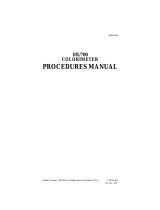
Instr. #5136
POOL & SPA WATER TESTS
Guidebook (#2004B) amplifies
these instructions and should be
read to use this product properly.
1. Read precautions on all labels.
2. Keep test kit out of reach of children.
3. Store test kit in cool, dark place.
4. Replace reagents once each year.
5. Do not dispose of solutions in pool or spa.
6. Rinse tubes before and after each test.
7. Obtain samples 18" (45 cm) below water surface.
8. Hold bottle vertically when dispensing.
Sodium Chloride (Salt) Test
For 1 drop = 200 ppm
1. Rinse and fill sample tube (#9198) to 10 mL mark
with water to be tested.
2. Add 1 drop R-0630. Swirl to mix. Sample should
turn yellow.
3. Add R-0718 dropwise, swirling and counting after
each drop, until color changes from yellow to a
milky salmon (brick) red. Always hold bottle in
vertical position.
NOTE: Do not add enough R-0718 to give a brown
color. First change from yellow to a milky
salmon (brick) red is the endpoint.
4. Multiply drops of R-0718 by 200. Record as parts
per million (ppm) salt as sodium chloride.
12/14
Free, Combined & Total Chlorine Test
1. Rinse and fill small comparator tube to 9 mL mark with water to be tested.
2. Add 5 drops R-0001 and 5 drops R-0002. Cap and invert to mix.
3. Match color with color standard.* Record as parts per million (ppm) free chlorine (FC).
4. Add 5 drops R-0003. Cap and invert to mix.
5. Match color immediately. Record as ppm total chlorine (TC).
6. Subtract FC from TC. Record as ppm combined chlorine (CC). Formula: TC - FC = CC.
Total Bromine Test
1. Rinse and fill small comparator tube to 9 mL mark with water to be tested.
2. Add 5 drops R-0001 and 5 drops R-0002. Cap and invert to mix.
3. Match color with color standard.* Record as parts per million (ppm) total bromine.
*If color is off-scale: Repeat test using 4.5 mL sample diluted to 9 mL mark
with tap water. Multiply reading by 2 to obtain approximate sanitizer level. If
color is still off-scale: Repeat test using 1.8 mL sample diluted to 9 mL mark
with tap water. Multiply reading by 5 to obtain approximate sanitizer level.
pH Test
1. Rinse and fill large comparator tube to 44 mL mark with water to be tested.
2. Add 5 drops R-0004. Cap and invert to mix.
3. Match color with color standard. Record as pH units and save sample if pH
needs adjustment. If sample color is between two values, pH is average of the
two. To LOWER pH: See acid demand test. To RAISE pH: See base demand test.
Acid Demand Test
1. Use treated sample from pH test.
2. Add R-0005 dropwise. After each drop, count, mix, and compare with color
standards until desired pH is matched. See treatment tables to continue.
Base Demand Test
1. Use treated sample from pH test.
2. Add R-0006 dropwise. After each drop, count, mix, and compare with color
standards until desired pH is matched. See treatment table to continue.
Total Alkalinity Test
1. Rinse and fill large comparator tube to 25 mL mark with
water to be tested.*
2. Add 2 drops R-0007. Swirl to mix.
3. Add 5 drops R-0008. Swirl to mix. Sample should turn
green.
4. Add R-0009 dropwise. After each drop, count and swirl
to mix until color changes from green to red.
5. Multiply drops in Step 4 by 10. Record as parts per
million (ppm) total alkalinity as calcium carbonate.
*When high TA is anticipated, this procedure may be
used: Use 10 mL sample, 1 drop R-0007, 3 drops R-0008,
and multiply drops in Step 4 by 25.
Calcium Hardness Test
1. Rinse and fill large comparator tube to 25 mL mark with
water to be tested.*
2. Add 20 drops R-0010. Swirl to mix.
3. Add 5 drops R-0011L. Swirl to mix. If calcium hardness is
present, sample will turn red.
4. Add R-0012 dropwise. After each drop, count and swirl
to mix until color changes from red to blue.
5. Multiply drops in Step 4 by 10. Record as parts per million
(ppm) calcium hardness as calcium carbonate.
*When high CH is anticipated, this procedure may be
used: Use 10 mL sample, 10 drops R-0010, 3 drops R-0011L,
and multiply drops in Step 4 by 25.
Cyanuric Acid Test
1. Rinse and fill CYA dispensing bottle (#9191) to 7 mL mark
with water to be tested.
2. Add R-0013 to 14 mL mark. Cap and mix for 30 seconds.
3. Slowly transfer cloudy solution to small comparator tube
until black dot on bottom just disappears when viewed
from top.
4. Read tube at liquid level on back of comparator block.
Record reading as parts per million (ppm) cyanuric acid.
/


